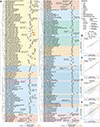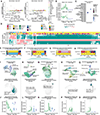A panoramic view of cell population dynamics in mammalian aging
- PMID: 39607904
- PMCID: PMC11910726
- DOI: 10.1126/science.adn3949
A panoramic view of cell population dynamics in mammalian aging
Abstract
To elucidate aging-associated cellular population dynamics, we present PanSci, a single-cell transcriptome atlas profiling >20 million cells from 623 mouse tissues across different life stages, sexes, and genotypes. This comprehensive dataset reveals >3000 different cellular states and >200 aging-associated cell populations. Our panoramic analysis uncovered organ-, lineage-, and sex-specific shifts in cellular dynamics during life-span progression. Moreover, we identify both systematic and organ-specific alterations in immune cell populations associated with aging. We further explored the regulatory roles of the immune system on aging and pinpointed specific age-related cell population expansions that are lymphocyte dependent. Our "cell-omics" strategy enhances comprehension of cellular aging and lays the groundwork for exploring the complex cellular regulatory networks in aging and aging-associated diseases.
Conflict of interest statement
Figures





Update of
-
A Panoramic View of Cell Population Dynamics in Mammalian Aging.bioRxiv [Preprint]. 2024 Mar 5:2024.03.01.583001. doi: 10.1101/2024.03.01.583001. bioRxiv. 2024. Update in: Science. 2025 Jan 17;387(6731):eadn3949. doi: 10.1126/science.adn3949. PMID: 38496474 Free PMC article. Updated. Preprint.
References
MeSH terms
Grants and funding
LinkOut - more resources
Full Text Sources
Medical
Molecular Biology Databases

